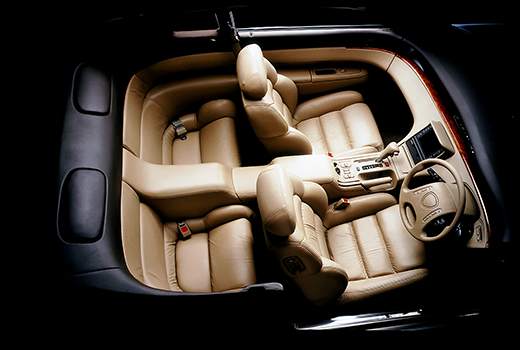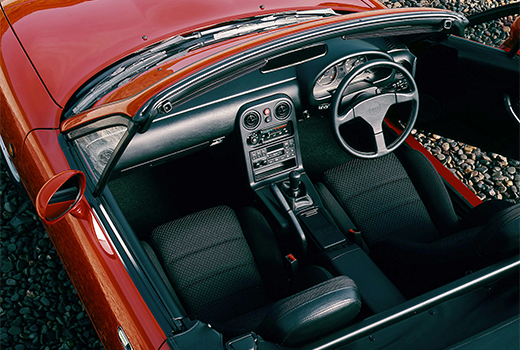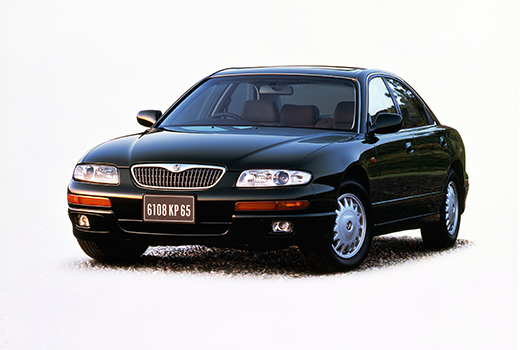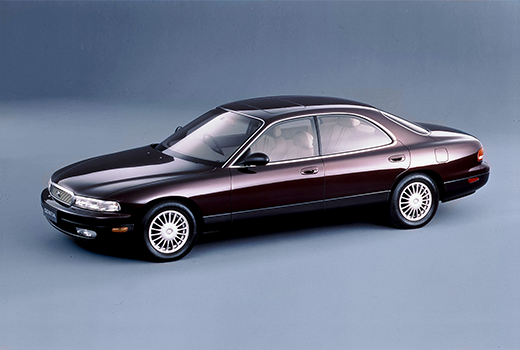in the bubble economy period
During the bubble economy period, Mazda introduced a very large number of new car models into the domestic market over a short period of time. Due to the expansion of its domestic sales network to five channels in 1989, a level worthy of major car manufacturers, it had become vital for Mazda to expand its lineup of vehicles in response to the increased number of channels.
In the following five years, Mazda launched more than 25 new models. Not only did the carmaker quickly ramp up its offerings, it also engaged in product differentiation. To develop new models to suit the characteristics of different distribution channels, special consideration was given to creating positive distinctions between vehicles, with an emphasis on their individuality. Buoyed by the economic boom and their ambitions for further business growth, Mazda’s engineers worked hard to incorporate novel and innovative designs and technologies into the new models. It truly was an animated period.
It is not easy to pick just one example of the many models Mazda introduced into the market during that period, but the Eunos Cosmo launched in 1990 created a major buzz at the time. With “the greatest rotary-engine car in history” as its slogan, the car was equipped with a three-rotor rotary engine, representing Mazda’s first attempt to mount the engine on a mass-produced vehicle. Moreover, only the best materials were adopted in order to create an interior space that would feel comfortable and luxurious to both the driver and passengers. These included, for example, top-quality Austrian leather for the seats as well as wood trim harvested from elm trees in France and polished by Italian craftsmen in Milan for the interior wood panels. In addition, the Eunos Cosmo was equipped with the world’s first GPS navigation system and other cutting-edge electronics, making it an unprecedentedly premium personal coupe.
Another iconic Mazda car at the time was the Mazda Sentia, a prestige sedan based on the concept of “a high-quality driver’s car” featuring supple suspensions and an elegant design, achieved by its uniquely low and wide chassis. The Eunos 800 also deserves a mention, a high-grade sedan equipped with the world’s first mirror cycle engine, providing all-round high-quality and claiming to offer “immutable decade-long value.” Mazda’s flagship cars were not limited to premium models, however. The Eunos Roadster, developed under the concept of “Jinba-ittai” (“unity of horse and rider”), achieved the status of a unique convertible sports car that provided both a sense of freedom and an enjoyable driving experience. The Autozam Carol, meanwhile, featuring bold, curvaceous lines for both the interior and exterior, was a likeable mini-vehicle with a strong presence. Indeed, the list goes on and on.
Nearly 30 years have passed since then. Although there are only a few of those cars left on the road, they belong to avid fans who continue to take special care of them. Their devotion gives Mazda renewed drive and inspiration.
Those cars had unique personalities and were attractive to many people. Although they might not have always achieved highly in terms of automotive manufacturing, each of them nonetheless had distinctive characteristics that strongly appealed to consumers. Their unique design, technology, or development concept touched a sympathetic chord, which has played a big part in these vehicles being especially memorable for people. All these vehicles reached new levels in terms of value that originated from the uncompromising pursuit of answers to two questions: “What can cars offer people?” and “What kind of car can enrich people’s lives?” The fact that these distinctive cars continue to see appreciation to this day, testifies to the importance of Mazda’s pursuit.


(known as Eunos Roadster in Japan) (1989)

(known as Eunos 800 in Japan) (1993)

Commercials for Anfini sales channel
Footage without audio